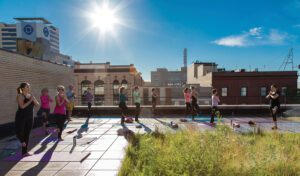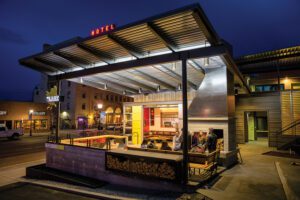As cities build out at breakneck speeds, developer Doug Burgum and architect Brian Caldwell look to vibrant downtowns as ways to build community from the inside out.
By Tyler Allen
The 1862 Homestead Act promised 160 acres of public property to settlers willing to stake their dreams on Western migration and by 1900 the act had led to the distribution of 80 million acres of federal land. The West was transformed.
Yet the U.S. government also had the foresight to reserve vast expanses of frontier in national parks, wilderness areas and national forests, securing protected lands for all Americans in perpetuity.
Today, however, public lands in the Rocky Mountains are feeling the burden as surrounding communities grow rapidly, applying unprecedented pressure on these spaces. Few examples better reflect this than Bozeman, Montana.
This university town, the population nexus of southwest Montana’s Gallatin County, is seeing explosive growth. The county holds more than 100,000 residents and if current trends persist that number will double by 2040.
The attraction to Bozeman, like other Western mountain towns, is clear. Exceptional skiing and mountain biking, blue-ribbon fly fishing, and abundant open space to view or hunt wildlife are just a few of the opportunities spurring a modern migration to this part of the country.
But unchecked outward growth risks jeopardizing the very open spaces, wildlife corridors and unfettered opportunities for solitude that draw the contemporary American pioneer to the new American West.
If Bozeman fails to maintain the qualities that draw new settlers—and keep the old—it could risk becoming another Denver by the turn of the next century. Some developers are looking to other models for answers: a way to build from the inside out.
Nearly 700 miles to the east of Bozeman, one city is being reimagined with vitality in mind. Sitting on the banks of the Red River and known as the “Gateway to the West,” Fargo, North Dakota, is experiencing a resurgence in its historic downtown led by the efforts of Doug Burgum and the Kilbourne Group.

As chairman and CEO of Great Plains Software, Burgum steered the growth of the small startup software company to its $1.1 billion acquisition by Microsoft Corporation in 2001. He served as the tech giant’s vice president until 2007 and in 2006 founded Kilbourne Group, driven by the motto “Vibrant downtowns create healthy, smart cities.”
Burgum is also running an outsider’s campaign to be North Dakota’s next Republican governor. With a shock of wavy silver hair and browline glasses, Burgum brings an academic appearance to reining in state spending and advocating local control of government. That platform is informed by his unique experience with public perception as an executive and developer.
Burgum’s first experience with urban renewal came in 2000, when he stepped in to rescue the 70,000-square-foot Northern School Supply building from demolition.
North Dakota State University moved its architecture and art programs into the formerly rundown warehouse rechristened Renaissance Hall, and Burgum saw the potential of downtown Fargo anchored by students and young professionals at its heart.
Others see this potential, too. In a March 2016 online column titled
“[Burgum’s] buildings and restorations have vaulted us into A.D.,” Stark wrote. “More progressive ideas, buildings and people followed.”

Mandan, North Dakota native Angela Renner saw this transformation firsthand. In 2003, she spent a year studying at Concordia College in Moorhead, Minnesota—just across the Red River from Fargo—and returned for a year in 2012 as an emergency room nurse at Sanford Medical Center Fargo.
“I don’t know why it happened [in Fargo],” Renner said, noting the influx of young professionals, the walkability of downtown and ubiquitous bike paths. “People are happy being in Fargo. They are staying there and making it the community they want it to be.”
It’s just the trend Burgum’s trying to capture.
“Part of the way cities grow is that you attract and retain workforce—people [who] want to live here,” Burgum said, pointing to a cultural shift in those entering and mobilizing within the workforce. When he left school, Burgum says it was all about finding a desirable company and moving wherever a position opened up. Today’s college graduates often choose places they’d like to live first then look for jobs.

“The economic development folks are starting to figure it out, and it’s not about recruiting companies it’s about creating great places for people to live. When we’re on a mission to create vibrant downtowns we’re basically driving this workforce concept for the whole city,” Burgum said.
Infill projects have economic benefits because infrastructure including roads, sewer and utilities already exists, preventing new taxes from being levied on the city’s population unlike construction on the edges of town.
“If people want small government, which a lot of people do these days, then you have to have a small footprint for your city,” Burgum said.
Both ends of the political spectrum can agree that having vibrant downtowns benefits everyone, he says. “It’s good for health, it’s good for workforce development and it certainly is good for keeping taxes down.”
Burgum has also seen the challenges and opportunities in Bozeman. As a member of the Yellowstone Club, the world’s only private ski and golf community, he’s an hour’s drive south of town.
“Like a lot of communities, [Fargo’s seen] a lot of new growth on the edge—no different from Bozeman,” he said. But while the 120,000-resident city of Fargo is reinventing its core, Burgum says Bozeman has preserved its historic downtown.
The Lark Hotel opened on Bozeman’s iconic Main Street in April 2015 and is already the most successful hotel in Montana on a per-room occupancy rate. Thinktank Design Group, the architecture firm behind the project, breaks ground in October 2016 on a 28-room expansion.
“We took an old motor lodge and adaptively repurposed it,” said Thinktank architect

Brian Caldwell, who founded the company in 1999 with his business partner Erik Nelson. “The most ecological thing you can do is not put [an old building] in a landfill.”
Burgum agrees, and says that renovating buildings with green roofs to mitigate stormwater runoff and zoning them mixed-use to encourage walkability are some ways his company is limiting its ecological footprint.
“Kilbourne Group looks at renovation of buildings as the greatest green thing we can do,” Burgum said. “People get excited about recycling plastic bottles but turn around and knock a building down.”
Caldwell sees the benefits of infill projects as essential to Bozeman’s future as a vibrant city. “Fundamental planning and making room for our population in the current footprint is critical to Bozeman,” he said. “Our development company believes strongly in identifying what needs exist and finding creative solutions in adding to the greater sense of community.”
One deficiency Thinktank has identified is a lack of space for live music and events in Bozeman. Instead of looking at new construction on the edge of town, they purchased the historic Rialto Theatre on Main Street in fall 2015 and begin renovation this June.
Like Burgum, Caldwell sees vibrant cities as a way to attract jobs and economic prosperity. He jokes about the “pay-per-view mountains” in small Western towns, where many professionals make half the income they would in large metro areas.
Thinktank believes the environmental impacts of its projects are paramount, and is building the second stage of the Lark Hotel using cross-laminated timber construction—an innovative design method incorporating prefabricated, solid wood panels that are environmentally low impact compared to conventional methods.
According to Caldwell, it will be one of the first structures of its kind in Montana. While it’s 10-15 percent more expensive than using traditional building materials, Caldwell says it’s worth the cost to be on the leading edge of green building and to address climate change. “It’s the most responsible way to build, period,” he said. Caldwell not only looks to wood construction as the past informing the future, but also a way to prop up Montana towns suffering from a declining logging industry.
“Using wood construction in our urban environment is the best way of helping rural communities,” he says, adding that archaic building codes favoring steel and cement have slowed cross-laminated timber’s development in the U.S. “There’s a paradigm shift that needs to happen to use wood [in construction] again.”
In Burgum’s eyes, Thinktank has already scored a win with the first stage of the Lark. “That’s an amazing project they did,” he said. And he sees the potential of cities like Bozeman and Fargo as a reflection of how they were first settled, before automobiles and strip malls pushed development outwardly.
Burgum believes this message will resonate with voters in North Dakota, a state experiencing budget shortfalls because of low oil prices, but also one with a number of communities home to historic downtowns.
“The state doesn’t realize that where they put their infrastructure can drive the economics,” Burgum said. “We’ve got a playbook developed in downtown Fargo.”
This story was first published in the summer 2016 issue of Mountain Outlaw magazine. Visit the contributing photographers’ work at Dan Francis Photography and Dan Armstrong Photography.















